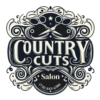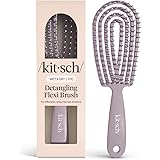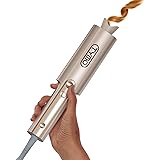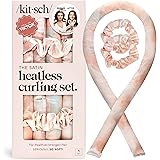Understanding Your Hair Type
Identifying your natural hair type is a crucial step in the journey toward embracing your natural hair. The classification of hair types generally falls into four categories: straight, wavy, curly, and coily. Each hair type has its own unique characteristics that dictate the appropriate care, styling methods, and products suited to its needs.
Straight hair, often classified as Type 1, is generally sleek and shiny, with little to no curl pattern. This type tends to be less porous, allowing for natural oils to travel down the hair shaft efficiently, which can result in a healthy shine. However, individuals with straight hair may find themselves challenged by volume and texture, necessitating specific products to enhance body and prevent grease.
Wavy hair, or Type 2, showcases loose, S-shaped waves. This type often presents a challenge in terms of frizz and can vary in density. Those with wavy hair should focus on hydrating products that enhance their texture while maintaining moisture to minimize frizz. A balance of styling gel and cream can define the waves without weighing them down.
Type 3 hair is categorized as curly, characterized by well-defined, springy curls. Curly hair tends to be drier due to its structure, as natural oils find it difficult to travel down the tight curl patterns. Therefore, individuals with curly hair should prioritize moisturizing products, such as leave-in conditioners, while also incorporating a curl-enhancing cream to maintain definition.
Lastly, Type 4 hair is classified as coily, featuring tight and voluminous curls known for their shrinkage. Coily hair often requires intensive moisture and regular deep conditioning to keep it healthy and manageable. Using heavier creams and oils can aid in defining curls while providing necessary hydration.
In understanding your hair type, it is beneficial to conduct thorough research. Online resources, including hair type charts and forums, can provide insight into the specific care routines that align with your hair’s unique characteristics. By recognizing and embracing your natural hair type, you lay a solid foundation for a successful transition journey.
The Decision to Transition
Deciding to transition to natural hair is a significant and deeply personal choice that often arises from various internal considerations. For many individuals, the desire for healthier hair is one of the primary motivations. Years of chemical treatments can lead to damage, breakage, and a lack of luster. Transitioning to natural hair allows individuals to embrace their hair’s natural texture and regain its health, ultimately providing a sense of empowerment and renewal.
Another critical aspect influencing the decision is the desire to break free from the societal pressures that often dictate beauty standards, particularly those that favor straight or chemically treated hair. Many people find themselves yearning for self-acceptance, which becomes a transformative journey upon deciding to embrace their authentic selves. This transition is not merely a change in hairstyle but a reclamation of identity that can foster confidence and self-love.
To assess readiness for this pivotal transition, individuals can reflect on a series of questions. For instance, what does natural hair mean to you personally? Are your motivations rooted in self-care or societal expectations? Additionally, consider whether you are prepared to commit the time and effort required for proper hair care and styling during the transition. It is also essential to evaluate support systems, such as family and friends, which can play a crucial role in this journey.
Ultimately, the decision to transition should resonate with one’s individual convictions rather than external pressure. By understanding one’s motivations and evaluating readiness through reflective questions, it becomes clearer whether pursuing a natural hair journey aligns with personal values and aspirations. This consideration not only helps in navigating the transition smoothly but also enhances the overall experience of embracing one’s natural hair.
Starting the Transition: Protective Styles
Transitioning to natural hair can be an exciting yet challenging journey, and one effective method to ease this process is by incorporating protective styles into your routine. Protective hairstyles, such as braids, twists, wigs, and up-dos, play a significant role in safeguarding the hair from environmental stressors, which can be particularly beneficial during the transition period. These styles not only allow for a break from daily manipulation but also help to minimize the risk of breakage, thereby promoting healthier hair growth.
One of the primary benefits of protective styles is their ability to conceal the chemically-treated ends while allowing the natural roots to grow out. This can reduce the temptation to constantly check and manipulate your hair, leading to less stress on the strands. For instance, opting for box braids or Senegalese twists can provide a versatile look while protecting your natural hair. Additionally, these styles can be a creative outlet, enabling you to explore various aesthetics without compromising hair health.
While wearing protective styles, it’s crucial to maintain the overall health of your hair. Regularly moisturizing your hair and scalp is essential, as dry hair can weaken strands and lead to breakage. Utilizing natural oils or leave-in conditioners can keep your hair hydrated. Moreover, make sure to avoid styles that are overly tight, as these can cause undue tension and contribute to traction alopecia. Allow your roots some time to breathe by alternating different styles and not keeping them installed for extended periods. Each protective style offers a unique opportunity to embrace your natural journey while prioritizing hair health.
Developing a Natural Hair Care Routine
Establishing a consistent natural hair care routine is pivotal for nurturing and maintaining healthy textures. A well-rounded regimen caters to individual hair types, addressing specific needs while promoting overall wellness. A key starting point is selecting the appropriate shampoo. Opting for sulfate-free shampoos is essential, as sulfates can strip natural oils and lead to dryness. Look for gentle, hydrating formulations that cleanse without compromising the hair’s moisture balance.
Moisturizing plays a crucial role in any natural hair care routine. The hair, especially in its natural state, can be prone to dryness, making it imperative to incorporate moisture-rich products. Regularly applying leave-in conditioners or hair creams helps maintain hydration. Another effective moisturizing technique is the LOC method, which involves layering Liquid (water or leave-in), Oil, and Cream products to lock in moisture. This method can be personalized according to specific hair types and preferences.
Deep conditioning treatments are another vital component of a successful natural hair care regimen. These treatments penetrate the hair shaft, providing essential nutrients and hydration. Incorporating deep conditioning sessions once a week or bi-weekly can significantly improve hair texture and health, making it softer and more manageable. Additionally, incorporating natural oils like coconut oil, jojoba oil, or avocado oil can enhance the conditioning process, nourishing the hair and scalp.
Furthermore, it is crucial to prioritize regular trims. Cutting off split ends and overall dead weight helps to maintain the hair’s health and promotes growth. Aim for a trim every 6-8 weeks, customizing the schedule based on individual hair needs. By implementing these steps—selecting appropriate products, moisturizing effectively, deep conditioning regularly, and trimming when necessary—individuals can develop a personalized natural hair care routine that nurtures their unique textures and ensures optimal health.
The Big Chop: To Cut or Not to Cut
The big chop is often seen as a significant turning point on the journey to embracing natural hair. For many individuals transitioning from chemically relaxed hair to their natural texture, this bold decision involves cutting off all relaxed ends, which can be both daunting and liberating. The emotional journey accompanying the big chop varies immensely from person to person, with some finding it empowering while others may experience a sense of loss.
One of the primary advantages of undergoing the big chop is the immediate opportunity to start fresh with healthy hair. By cutting away damaged and chemically treated ends, individuals can cultivate their natural texture without the weighing effect of previous treatments. This clean slate can invigorate one’s self-image, fostering a sense of authenticity. Many people report feeling a profound connection to their hair after the big chop, viewing their natural curls and kinks as a unique expression of their identity.
However, the big chop is not without its challenges. The emotional transition can be difficult, especially for those who have long associated their appearance with straight or relaxed hairstyles. Feelings of vulnerability and insecurity may arise post-chop, particularly in environments where textured hair is not the norm. Additionally, the sudden change in hair length can take some time to adjust to, leading many to contemplate whether a gradual transition might be a better fit for their lifestyle.
Alternatives to the big chop, such as the “transitioning method,” allow individuals to retain their length while gradually trimming relaxed ends over time. This approach provides more flexibility and can ease the emotional sting of loss. Personal testimonials highlight the varied experiences; some individuals thrive after the big chop, while others prefer a more gradual approach to their journey. Ultimately, the choice between cutting hair or transitioning gradually hinges on personal preferences and comfort levels. It’s crucial for individuals to reflect on their motivations and feelings to determine the right path for their natural hair journey.
Embracing Your Natural Texture: Acceptance and Confidence
Embracing natural hair is not merely about changing hairstyles; it involves a profound journey of self-acceptance and confidence. Societal beauty standards often perpetuate a narrow definition of attractiveness, predominantly favoring straight and sleek textures. However, it is essential to recognize that beauty encompasses a wide array of hair types and textures. By embracing one’s natural hair, individuals can challenge these narrow ideals, fostering a sense of personal empowerment.
The first step in this journey is acceptance. Acknowledging and appreciating your unique hair texture is pivotal. This can be a significant departure from years of conforming to external expectations. Encouraging self-reflection and self-love can help individuals redefine their beauty standards. Understanding that each curl, wave, or kink tells a story of individuality can aid in this transformative process. Celebrating imperfections and understanding that they contribute to one’s uniqueness can pivot the focus from societal norms to personal authenticity.
Building confidence as one transitions to natural hair can be a gradual journey. Many find that documenting their progress through photographs or journaling can serve as effective motivation. Engaging with communities, both online and offline, that promote natural hair acceptance provides a supportive environment for sharing experiences and tips. Connecting with others who are also embracing their natural texture can reinforce positive self-image and help combat any feelings of isolation.
Moreover, exploring various styles and hair care routines that cater to one’s unique texture fosters experimentation and joy. This exploration can transform the perception of natural hair from a source of anxiety to one of pride. By recognizing the beauty inherent in diversity, individuals can become advocates for themselves and others, encouraging self-acceptance and confidence in embracing natural hair.
Styling Techniques for Natural Hair
Embracing natural hair textures can be both a rewarding and fulfilling journey, especially when applying the right styling techniques. Various methods can cater to diverse hair types, enhancing the natural beauty and uniqueness each texture possesses. Popular styling techniques include wash-and-go, twist-outs, and protective styles, all of which can be tailored to suit individual preferences.
The wash-and-go style, favored for its simplicity, involves cleansing the hair and applying a leave-in conditioner followed by a curl-defining product. This technique is ideal for those with curly or coily textures, allowing for a quick and effortless defined look. To achieve this, a wide-tooth comb can help to evenly distribute the product, ensuring that each curl is defined. Additionally, utilizing a diffuser attachment on a blow dryer can enhance the curls’ definition without causing frizz.
For those seeking elongated curls, the twist-out method is an excellent option. This technique involves sectioning the hair, twisting small parts, and letting them set, either air-drying or with the aid of heat. The result is beautifully defined, bouncy curls. Using a curl cream or styling gel during the twist process can aid in holding the shape and reducing frizz. Similarly, braiding the hair in sections can create a beautiful braid-out, offering a different texture and volume while also serving as a protective style.
Protective hairstyles, such as braids or buns, are essential for reducing manipulation and protecting the ends of the hair from damage. These styles not only promote hair growth but also allow for versatility in looks. It is important to choose lightweight products to avoid buildup and to ensure that hair remains nourished. Emphasizing the right techniques and tools can transform one’s approach to styling natural hair, promoting healthier hair and empowering confidence.
Dealing with Challenges and Setbacks
Transitioning to natural hair can be an empowering journey, but it is not without its challenges. One of the most common issues many individuals face is product buildup. As the hair transitions, it may require different products that cater specifically to natural textures. Unfortunately, using products loaded with silicones or heavy oils can lead to residue accumulation, making the hair appear dull and lifeless. To combat this, it is essential to incorporate clarifying shampoos occasionally to thoroughly cleanse the scalp and hair. Additionally, opting for lightweight, water-based products can help prevent buildup while nourishing the hair.
Another prevalent challenge during the transition phase is dryness. Natural hair textures may be more susceptible to dryness due to the structure of the hair strands, which can make it difficult for moisture to travel down the hair shaft. To address this, establishing a consistent moisturizing routine is vital. Utilizing products rich in natural oils, such as argan or jojoba oil, can help retain moisture. Moreover, implementing a regular deep conditioning regimen can provide the necessary hydration to keep the hair healthy and manageable.
Styling confusion can also hinder progress, especially for those unfamiliar with their natural hair patterns. It can be overwhelming to navigate the plethora of styling options available. To alleviate this, it is advisable to explore various techniques and styles while being patient with oneself. Tutorials and resources available online can serve as excellent guides for discovering suitable hairstyles. Connecting with a community of individuals who are also embracing their natural hair can provide additional support and encouragement during this transformative period.
While these challenges may appear daunting, it is crucial to remain steadfast in the journey. Patience and perseverance are key, as natural hair often requires time to flourish fully. Embracing the journey and focusing on progress over perfection will ultimately lead to a rewarding experience.
Community Support: Finding Your Tribe
Embracing your natural hair often involves a journey filled with ups and downs, making community support crucial during this transition. The natural hair community, a vibrant and diverse network of individuals, provides invaluable resources that can smooth the path. Engaging with fellow individuals who are also in the process of transitioning allows for sharing experiences, seeking advice, and receiving encouragement when challenges arise.
Social media platforms such as Instagram, Facebook, and TikTok have become essential spaces for connecting with others who embrace their natural hair. These platforms host numerous groups and pages dedicated to natural hair care, where individuals share personal stories, techniques, product recommendations, and styling tips. Furthermore, hashtags related to natural hair can lead users to a wealth of information and supportive voices, reinforcing the idea that they are not alone in their journey.
Online forums, such as CurlTalk or the Natural Hair Community, offer safe spaces where members can post questions, engage in discussions, and exchange helpful resources. These platforms enable individuals to learn from collective experiences and empower one another through encouragement. Many local communities also have support groups or meet-ups organized by individuals passionate about natural hair. These gatherings create an opportunity for face-to-face interactions and foster friendships with people who share similar goals and challenges.
In essence, finding your tribe in the natural hair community is about taking steps toward building meaningful connections. The support available can significantly ease the transition process and instill a sense of belonging and acceptance. By actively participating in these communities, individuals not only gain knowledge but also inspire others, creating a ripple effect of encouragement and empowerment within the natural hair movement.






